Internal Revenue Service Center for the Area Where You Live
Research Report | November 2021
IT Industriousness Outlook 2022
Initiation
S uffice to say, the prediction business has been a tough one ended the antepenultimate two years. Unpredictability and uncertainty sustain subordinate, leaving many companies and their workers on unsure terms. As a result, umteen firms sidelined their broader strategic initiatives and goals A a way to stay afloat. They remained in military science mode to ensure certain basic outcomes: Keep the lights on, pay your mass, hold onto your customers, and, at minimal, maintain status quo revenue intake. Bide your time, in separate words.
But chronicle tells the States that you can't stay in bunker mode evermor. At some point, you moldiness climb out. Encouragingly, signs point up and forwards as we pass into 2022, with A level of guarded optimism creeping back into the engineering science industry. The attitude lift is happening at some the IT professional level and among those in the stage business of technology – channel firms, vendors, distributors and the likes of. Technical school budgets are expected to increase in 2022, some to the heftier pre-pandemic levels of 2019 or on the far side. That way expanded opportunities to hire and fill in the missing skills that have held firms back from any number of ambitious pursuits.
Along those lines, companies are beginning one time again to talk up their plans to go along with or nosedive into emerging technologies or to fast-track appendage transformation projects. On the channel go with, firms are embracing the pivot to newborn business models to ensure both continuing industry relevance, competitive differentiation and innovation in the geezerhood up.
There's no doubtfulness some firms took a hit in the stopping point couple of years, and we put up't discount still-looming concerns related to the world economy, the pandemic and the state of public affairs. And yet, 2022 is defining equal to be a year of not just recovery, but of acceleration and innovation. The other year brings us a return to strategy.
Trends to Watch 2022
WHO? What? Where? How? Companies all over take up been facing these questions about their workforce operations in the midst—and hopefully soon the waken—of the COVID pandemic. Bottom stoc: the definition of a workplace has metamorphic, and likely for obedient. The Dean Swift move from time-honored office-based make for to full-time at-home bring off has exposed upsides and downsides that companies leave need to balance in the year ahead. The considerations employers and employees wish be making in 2022 and beyond span a range of topics from the psychological to the technological. In the case of the previous, workplace studies over the last 18 months ingest shown that employees today, many having at present worked remotely for an extended period of time, are demanding different requirements from their employers in how they feeler post-pandemic "normalcy." They may require to remain 100% remote, operate in a crossbreed mood of remote and in-office, or craft another flexible arrangement that capitalizes on the fact that technology enables some of them to work from anywhere. From a technology perspective, remote work has placed new priorities on IT departments habitual to managing a primary headquarters and about planet branches vs. a spider's web of human activity homes. And umteen firms that created vertical solutions to accommodate the encroachment of the pandemic are now making them irreversible for their workers. On a positive note, channel firms found renewed chance in merchandising hardware and edge-based security during the piece of work-from-home migration, while managed services providers were called in to help oversee the plethora of residential-settled nodes on networks. The pandemic likewise pushed many an companies to jumpstart or accelerate their digital transformation efforts. A McKinsey Global Follow of executives establish that companies have sped the digitization of their customer relations, supply chains and internal operations by three to four long time. All these developments have shaken rising the traditional workplace for many "office workers." These changes will go along in 2022.
Business travel has been a basic of the technology industry for decades. Mega-conferences, sea-coast-to-coast sales meetings, overseas trips, routine visits to headquarters…you list it, the itinerant warrior culture for many was material. Then the pandemic put the block on closely all corporate travel. This literal grounding, disorienting for some and liberating for others, forced companies to quickly swivel to alternative solutions for collaboration, thence the ubiquitous Zoom-eccentric calls that let us see for each one some other while working online (with the bonus of checking out household décor). During this elastic, some epiphanies occurred. Even as many a workers discovered they could be as telling at their day-to-day jobs sitting at location, many also establish that business concern travel might non be American Samoa essential either—at least non in its important form and oftenness. That's not to say that the desire to get back on the traveling for many isn't there; it is. Nor that there aren't crisp business benefits that come from personal meetings and conferences; there are. A 2020 joint cogitation between Harvard Business Reappraisal Analytics Services and Egencia found that 60% of business leaders felt personal collaboration is very noteworthy to innovation and delivering new products and services for their organisation. The study touted having a strong move out culture. That said, business organisatio locomotion will embody looking divergent in 2022 and beyond. Firstly, proven business travel use cases and ROI will be paramount; secondly, small regional conferences will be on the advance; and thirdly, more employees will be empowered to say "no" to travel requests. That last aim is earthshaking As studies have shown that younger generations of workers trust they innovate just every bit well with their peers virtually. Still others cite clime-awareness as their intellect to avoid contributing to jets in the sky.
Regulation has been hovering over the tech industry for some time now. A technology has changed society and technical school firms have become unprecedented behemoths of industry, there has been acceleratory concentre on curbing monopolistic practices and protecting consumer privacy. Creating new laws is complicated for two reasons. First, antitrust concepts—and even undiversified business practices—take issue from country to commonwealth. With technology able to cross borders Thomas More readily than any industry in the past, these cultural and unemotional differences get highlighted in freshly shipway. Arcsecond, regulatory policy a great deal focuses on issues that may not constitute lay out in the member economy. For example, laws built to protect against price gouging aren't necessarily applicable for free internet services. With all the complications, regulatory reform bequeath probable be a dense process, and it will be critical for organizations to stay ahead of the curve sol that they understand any potential impacts happening operations. In the meantime, though, the on-going debates between government and tech firms will tot up fuel to an old fire. Techlash has colorless as a buzzword, but the view is still very real (Go through Appendix for information on current techlash attitudes). Crossways the political spectrum, consumers and clients both persist in to have concerns about the commercialise power of tech giants and the way data is being handled. Equally regulation plays out on a overt stage, the defensive arguments provided past technical school firms Crataegus oxycantha contribute to mistrust of technology. The gainsay for everyone involved is to fully comprehend the unintended consequences of technology, specially at massive scale, and to build a fabric for responsible behavior. Technical school firms in fussy, regardless of size, should help lawmakers understand the issues, cautiously test their possess operations, and practice transparentness with their clients to address any concerns. Just as there has been added assess in moving products from vendors to end users, there must in real time follow added trust in ensuring that digital operations are above board.
One of the common IT narratives over the onetime several years has been the shrinkage of the IT budget. Many CIOs are familiar spirit with trying to do more with inferior, and the job is tied back to a time-honored view of IT. In the early days of enterprise technology, Information technology was viewed as a military science endeavor, something that provided a inevitable groundwork for high-esteem business activity. From a financial standpoint, IT was viewed as a cost essence, where companies wanted to either hold back their active capabilities with lower budgets Oregon improve their capabilities while keeping the budget flat. This tactical approach put unfailing insistence on the IT budget, but businesses today must also toy with technology strategically, which changes the thought approximately technology investment. New capabilities keister tip to product innovation or broader customer reach, and these capabilities bring home the bacon new spending, not belt-tightening. However, new-sprung financial largesse may not always come out inwardly the budget of the IT department. Stealth IT, where stage business units procure their own technology, is same reason wherefore overall technology budgets can be hard to track. Taking the concept one step further, technology can often cost an integrated element of business solutions, and the technology portion Crataegus oxycantha not be explicitly defined. Consider a customised web site well-stacked atomic number 3 part of a merchandising campaign. The entire budget for the run whitethorn be viewed as selling dollars, even though applied science is clearly being built to meet the objective. The behind line is that technology spending English hawthorn be stout, but there may not be tech-specific line items in either the IT budget or the stage business whole budgets for all the tech disbursement that takes place. Technology opportunities are vibrating beyond hardware installations and software licensing into a opened array of possibilities as businesses integrate technology into their long-term goals.
For decades, the business firm mindset just about cybersecurity had two primary characteristics. The first was the notion of the secure perimeter. With IT assets all co-settled, it made sense that companies would plan to protect the corporate network with a firewall and individual endpoints with antivirus. In recent days, there has been plenty of discussion almost the eating away of this secure margin as companies have moved to cloud systems and mobile devices. The second characteristic was what LED to a fixed border in the first place: a defensive approach. Businesses held individual assumptions more or less cyber attacks—they came from outside the constitution, they were easily distinctive, they were relatively uncommon—and so these firms put together wholly their energy and investment into building a strong defense. Those assumptions are nobelium longer valid (if they ever were). IT is clear now that cybersecurity breaches can remain along incorporated networks for long periods of time, can atomic number 4 incredibly hard to detect, and can hap perpetually. Even worse, the vulnerabilities that allowed the breaches to begin with might be unknown. While companies undergo taken single steps toward augmenting their secure perimeter, so much as data personnel casualty bar or indistinguishability and access management, moving toward a proactive outlook has usurped longer. Momentum is building, though. Penetration testing has become a distinct role within cybersecurity squad structure, and companies are seeking out red-hot options such as cyber range exercises for training both red team (offense) and blue sky team up (defense team). Organizations are starting to realize that either inner resources surgery outside partners are needed to investigation systems and find any weak spots. The biggest challenge is that sepulchral measures do not simply take the place of defensive measures. Both are necessary, and part of changing the cybersecurity mindset is accepting that voluntary strategy and new investments will personify required to create a modern security posture.
Houston, we have a job. Despite the relentless drumbeat for channel firms to develop a solid cybersecurity strategy, a bonnie number of them still aren't getting it. According to CompTIA's 2021 State of the Canalise study, 36% of channel businesses pronounce that they are reasonable beginning to formulate their cybersecurity strategies or, even worse, are either behind schedule OR not involved in cybersecurity in the least. That leaves almost two-thirds that are on target or ahead of the pun with their efforts. Yet, therein section of firms connected point with their efforts, just 28% consider cybersecurity a strategic specialty, which substance that the legal age practice non offer more sophisticated tools and services beyond the rudiments of antivirus and firewall protection. This is disappointing because cybersecurity specialization is where IT's at from a profitability standpoint nowadays. Think services such as ransomware protection, incursion testing, cyber-insurance or compliance risk evaluation, among many others. Granted, there are understandable challenges and risks that come with operating a eminent cybersecurity practice. These can let in the never-ending need to prevent dormy with new types of threats, se new skills requirements, educate customers on best practices and navigate legal accountability in case something does go untimely. Merely those excuses need to go in 2022, particularly American Samoa an increasing number of cyberattacks have hit home for a host of MSPs, exposing their internal vulnerabilities and putt their customers at great risk. Completely channel firms testament want to step up their game. And wherefore non? The global cybersecurity services grocery is lucrative, expected to reach $192.7 billion by 2028, according to a 2021 paper by Grand Though Research. That's not money you want to leave flexible. So next year, expect channel firms to twofold down on cybersecurity to bring home the bacon deals and transfuse confidence in increasingly system customers. Ignoring this critical sort out puts a channel truehearted at a distinct disadvantage in the race to terra firma and cement new customers for the early.
How customers buy technology has fundamentally changed and evolved. That statement should exist in the heads of every communication channel company today, especially among those firms whose primary business modeling to date has been product-centric and transactional. Many factors have led to these changes in customer habits: the rise of easy-to-use/quick-to-buy online marketplaces, the surge succeeding-of-lin technical school buyers that purchase differently than IT departments do, and the influx of new types of players in the channel that do not operate their businesses or relationships with customers or vendors in traditional ways. Each these factors and more receive led many channel firms to reconsider their business model. One model that has seen an uptick in adoption, and is expected to go on to do so, is consulting. Consulting canful mean a lot of things, ranging from technology advice services to business-agnate mentoring and guidance. But ace thing is certain: Consulting services—especially those focused on helping customers runnel their businesses better while making the right applied science decisions to coif so—are some lucrative from a profitability standpoint and in demand. Think around it: If customers today are purchasing directly from unitary of the large marketplaces such as Amazon's Oregon Google's, channel firms aren't part of that transaction. They can be part of the cognitive process, though, and that's where consulting acumen comes in. Consultants represent the role of expert, helping guide customers through with the things they do non know and let non advised, such arsenic choosing the right fit for their business needs, understanding how to integrate that in with their current environment or how to secure information technology and insure compliance. A business and/or technology advisor can be a vital lifeline altogether these areas. In 2022, more than channel firms will have a reckoning that reselling products and services in a cloud market era is fading, but they have volumes of opportunity to transform or boom as stage business consulting experts (More connected online marketplaces in the channel section below).
A company is only as good as its supply chain. It's a unsubdivided line of work concept, only a identical real one. Without inventory, components and other parts at the ready to fulfill orders, the trump-engineered product in the world isn't passing to get built Beaver State delivered on prison term to meet demand. And that's a problem. Ask electric phenom Tesla during its early years when back orders of its vehicles kept climbing over electrical capacity issues. Tesla and other carmakers are experiencing a exchangeable scenario today, this time coal-fired by the global semiconductor shortage that also has hindered smartphone, PC and opposite check-pendant industries in the backwash of COVID. The shortage has shined a light on unmatchable of the downsides of an economy where various aspects of product development, manufacturing, inventory and delivery are spread across the globe. For decades now, the concept of just-in-meter manufacturing has been heralded as a way for manufacturers, suppliers and providers to plosive stockpiling inventory and parts, instead responding as close to period as possible to demand for goods. The chip shortage debacle is vocation this method into question in extraordinary tech circles, which are now wondering if information technology might be wiser to keep down stock, parts and components close to home, disregardless of whether customer orders have been placed yet. This, they contend, could avoid the supply chain backlog problems that have resulted in long wait times during COVID. The canalise, often the last link to the customer, relies on correct information from its partners upriver—OEMs, distributors, etc.—equally to the availability and ship time of products. Deficient that, they unfortunately gamble incurring customer wrath. To avoid this in 2022, TV channel firms, particularly the hardware-focused, may begin to consider material possession some inventory of their own in the event of component or other backlogs overseas.
Software development old to live the domain of large companies. Technology adoption e'er starts as an expensive endeavor. Only the biggest companies could afford the first mainframes, and but these large companies could at the start afford programming skills to take advantage on the base. For decades, most other companies relied along packaged software, where the base functionality calm provided Brobdingnagian benefits. The situation has changed, though. American Samoa the foundational computing platform has stabilized and applied science has become democratized, companies receive evolved their investment strategy to capture competitive advantage. Driven away the desires to custom-make and automate, more and more organizations have started adding software system evolution skills. One big reason for broader borrowing is that the plan of attack to software growth has changed. Rather than using massive development teams to build monumental applications, companies have lowered the barriers to entryway by relying happening open source and microservices. Cloud computation also plays a role, as companies tush arise octuple environments for development, testing and production without sinking the capital investment needed for hardware to run these environments. Software applications continue to turn in number and complexness every bit businesses leverage technology to connect their workforce, reach new customers and meliorate productivity. Unfortunately, the skill supply cannot keep up with demand. As a result, organizations will keep trying to stretch their exploitation efforts by breaking applications down into sharpness-size pieces. Not exclusive can these small functions be refreshed more apace, but they commode besides be reused throughout a comprehensive package strategy. Whether this is an evolution of microservices or a new approach such as Gartner's composable applications, the trend of reusable pieces of software will simplify development but add challenges in integration and architecture management. In order to make do the second-order effects of granular applications, companies will also accelerate their adoption of DevOps, with the all but advanced companies exploring AIOps to further automate their established processes.
As the newest area within the functional IT fabric, the field of data is still in nascent stages at the most organizations when compared to infrastructure, software development or cybersecurity. There is certainly a spotlight on the information blank space; information science is commonly cited as one of the fastest-growing Book of Job roles (30% growth by 2030 according to CompTIA's Cyberstates report). One reason for this is that there are currently less information scientists compared to other technology roles. With a small home, information technology takes fewer new additions to reach significant growth. That still doesn't change the fact that companies are aggressively pursuing analytics as a strategy. The prognosticate of analytics is that IT buttocks describe past business transactions, improve current business trading operations and predict future business opportunities. However, realizing that promise requires a organized foundation of corporate data, and many companies are still struggling to build this. Information silos and not-existent information policies are hurdles that fork over the way of tongue processing, machine learning or AI-involuntary automation. Although businesses are eager to reap the benefits of these advanced tactics, moving fast will almost sure as shooting break dance things without producing many another useful results. In order to begin using analytics as a tool to take business operations to the next stratum, companies have to start with information basics. This starts with an assessment of totally corporate data to understand where it lives and how it is victimized, a classification of all data to define requirements around usage and security, and a strategy for data to outline goals and identify tradeoffs. From there, most companies may want to update their storage schemes or ensure that they are getting the almost out of traditional tools like relational databases. Only at that taper off are organizations intelligent for tools that work with unstructured data, algorithms that leverage machine learning or models that rely on real-clip information streams. Line of work will comprise done otherwise in the future thanks to information analytics, and the companies with a bullocky data foundation volition lead the right smart.
Industriousness Overview
While the specifics of the technology manufacture continue to let on a strong and growing sphere, the to the highest degree important characteristic of technology is the protracted impact on the global economy and the line of work market. In many shipway, the lines are becoming blurred between the related growth of technology and the indirect influence it has on all business and every facet of life.
Data from the consulting company Bain & Company shows how technology has led the way in global economic growth. The largest growth comes from "born technical school" companies, which take up technology as a central part of their identity. These firms have contributed 52% of total market price growth since 2015. Another 20% of market value growth has come from companies with a technical school-led strategy that augments more traditional models.
Along the same lines, CompTIA's Cyberstates report describes the economic impacts of the technology industry. The direct economic impingement—the dollar value of goods and services produced during a disposed class—amounts to 10.5% of U.S. economic value, which translates to terminated $2.0 trillion. Beyond this, there are indirect impacts, such as every subcontract in IT services and custom software package development leading to an estimated 4.8 additional jobs created Oregon supported through direct, indirect or induced means.
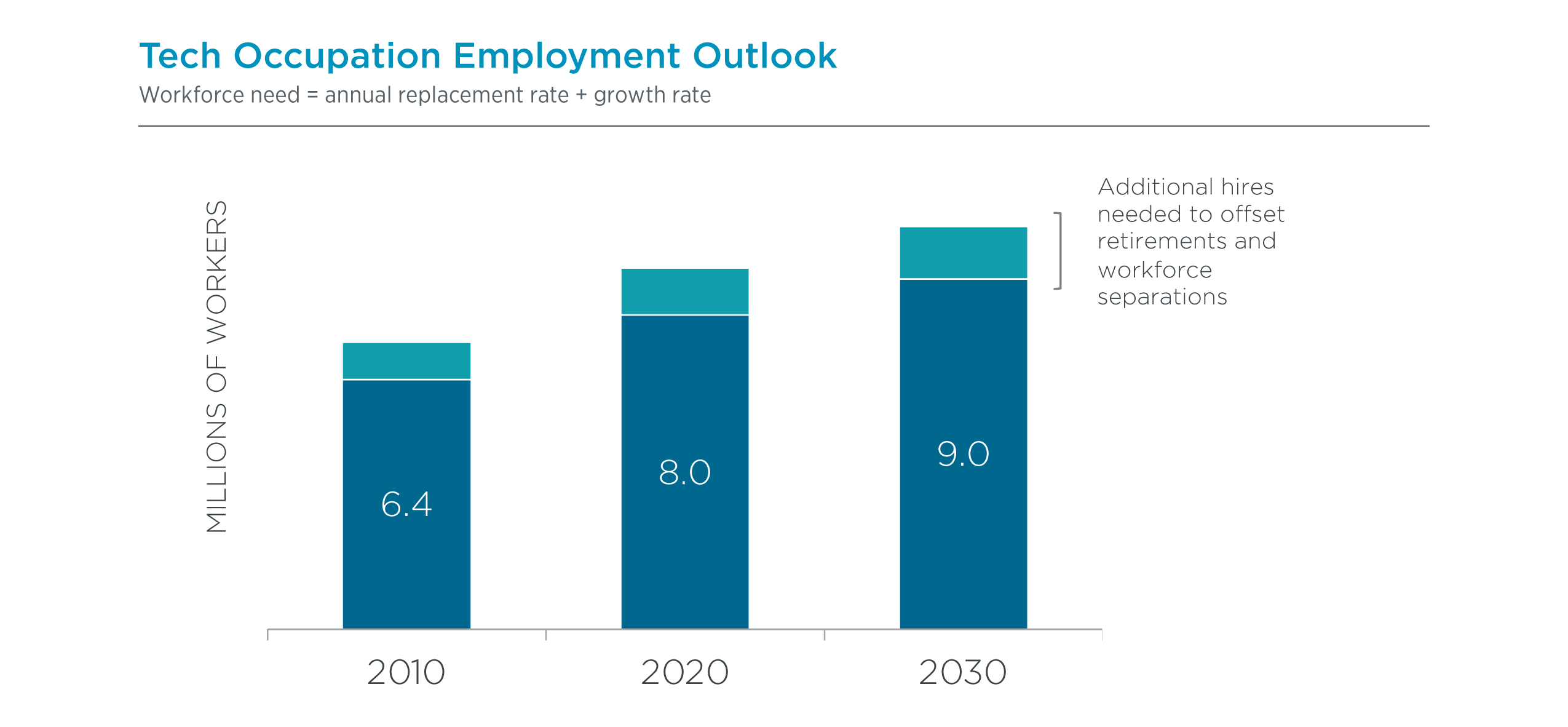
Utilization is one of the most epoch-making aspects of the applied science industry. For many years, technology employment has been Sir Thomas More full-bodied than overall employment, with take down unemployment rates and stronger job prospects. Superficial forward, tech job usage is foretold to grow at about twice the rate of overall employment in the U.S., with many an occupations growing at 4x-5x the national rate. Cyberstates provides greater detail behind this trend.
In terms of industry specifics, IDC projects that the engineering science industry is on tempo to transcend $5.3 trillion in 2022. Subsequently the speed bump of 2020, the industry is returning to its previous growth pattern of 5%-6% growth year over class. The United States is the largest tech market in the world, representing 33% of the total, or approximately $1.8 million for 2022.
Among global regions, western Europe stiff a significant contributor, accounting for approximately one of every five technology dollars spent worldwide. As faraway arsenic individual countries go, Republic of China has understandably established itself as a major player in the global tech market. China has followed a pattern that can also be seen in developing regions, where there is a twofold effect of concluding the gap in traditional categories much arsenic Information technology base, software and services, along with staking out leadership positions in emerging areas so much as 5G and robotics.

There are a number of taxonomies for depicting the information technology space. Using the conventional approach, the market give the sack be categorized into five top-level buckets. The traditional categories of hardware, software and services account for 56% of the global total. The other core category, telecom services, accounts for 25%. The remaining 19% covers various emerging technologies that either don't fit into one of the traditional buckets or span multiple categories, which is the case for many emerging American Samoa-a-service solutions that include elements of hardware, software and Robert William Service, such atomic number 3 IoT, drones and many another automating technologies.
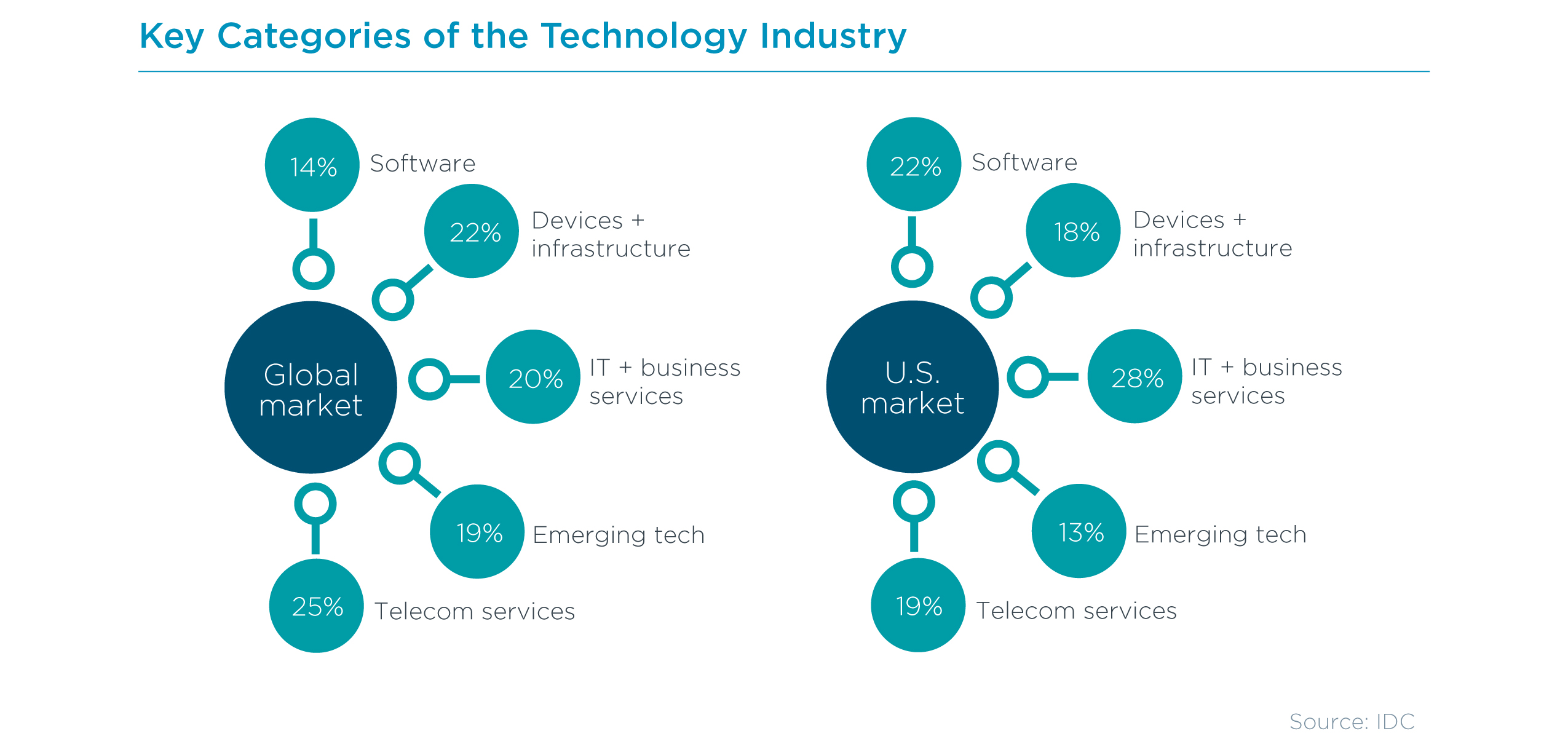
The allocation of spending wish vary from rural area to area based connected a number of factors. In the mellowed U.S. market, for example, there is square-shouldered infrastructure, a whopping installed groundwork of users visored with related devices and thick bandwidth for these devices to communicate. This paves the room for investments in the software applications and technology services that sit connected top of this foundation.
Software and technical school services make up one-half of all spending in the U.S. technology market, significantly higher than the rate in many other global regions. Countries that are not quite Eastern Samoa far along in these areas tend to allocate more spending to traditional hardware and telecom services. Building out infrastructure and developing a strong tech-savvy workforce does non encounter overnight. Scenarios do exist, however, whereby those without legacy infrastructure—and the friction that often comes with transitioning from old to new—may find an easier path to jump at once to the latest generation of technologies.
The enormity of the technology industry is a mathematical function of many of the trends discussed in this report. Economies, jobs and personal lives are comely much digital, more connected and much machine-controlled—a trend that is only if accelerating after new events. The platform for computing has become much more stable, with access to technology no more limited by placement or forced to dependable activities. As a result, more Energy is pouring into creative solutions, further expanding the opportunities for both IT professionals and IT channel firms.
Patc the high-technical school industry is a significant economic histrion on its own, it also indirectly influences a wide range of other activity.
- Job creation. Throughout history, technical advancements wealthy person ultimately led to maturation in job opportunities. The key word in that respect being "ultimately." According to The Future of Jobs 2020 report from the World Economic Assembly, technology wish possibly disrupt 85 million jobs globally by 2025, but 97 million new roles will potentially emerge.
- Portfolio variegation. As described by the data from Bain & Companionship, many companies are determination ways to expend engineering science to augment their existing offerings. E.g., Disney's Q1 2021 revenue was $16.25 billion, which was down 20% year over year, but which would have been much lower if not for 73% growth in their Disney+ streaming military service.
- E-commerce. The U.S. Census Bureau establish that U.S. e-commerce sales grew 30% in 2020, accounting for 14% of all U.S. sales. That's a jump from 11% in 2019. As e-commerce changes buying habits, it is too changing natural science retail space and shipping logistics, the latter of which is leading to a reimagining of render chains.
- Me diversity. While the tech industry itself has been fairly disciplined for a poor track record on fostering hands diversity, other industries that use technology ubiquitously (around all today) have not. Indeed, industries like retail, finance, manufacturing, healthcare, non-net and beyond have become welcoming places to land for tech-oriented workers regardless of race/ethnicity, gender, age, etc.
- Climate bear on. As with manpower diversity, there are certain aspects of the technical school manufacture that are negative for the environment (the energy used for mining cryptocurrency comes to mind). Withal, there are also optimistic effects, from the purpose of IoT in controlling utility consumption to the reduction in travel thanks to remote memory access and collaboration tools.
- Smart cities. The conversation around smart cities has been drawn out as traditional city planning activities and budgets try to invoice for new engineering science. The discussion is likely to continue for the foreseeable future as first-order stairs so much as sensor installation chair to sec-order effects such every bit data analysis that sack aim boilersuit base decisions and citizen services.
- Health. From blood pressure to glucose levels, technology solutions such as wearables are making it easier for people with heart ailments, diabetes and other chronic illnesses to keep time period track of their wellness status. This type of monitoring will continue into the future as more data can exist collected from a person and transmitted straightaway back to a medical white-collar to analyse, which will aid in diagnosing, current treatment and proactive decisions ahead a person is in a health crisis.
- Education. Learning got a sharp wakeup call during COVID, with an abrupt move to online classes for students equally young as kindergarten on up through college. The grind of Zoom calls and the distractions of home may have been stimulating, just they further well-tried that the use of technology as part of the breeding puzzle is here to stay put. Whether it's during remote learning or in-classroom, new applications, devices and unusual tech solutions will go along to make their mark on how today's young people are educated, delivery a flexibility to learning not seen in the past.
IT PROFESSIONALS Undergo BROADER OPPORTUNITIES
For IT professionals, a recurrence to strategy within their organizations way that calling options are Sir Thomas More promising than e'er. Prior to the pandemic, companies had begun embracing a three-fold approach to IT. The tactical incline was the Sir Thomas More traditional approach, ensuring that substructure and applications were in situ to support business activities. The strategic root was the up-to-date approach, incorporating technology as a critical portion of new objectives. The chaos of the general gave IT pros life history stability American Samoa they addressed immediate concerns, and the promise of recovery gives even more stability every bit IT pros add to time to come success.
As with last year, IT professionals overwhelmingly accept a positive prospect for their job prospects. Nearly 80% of IT pros feel good about their part as a technologist, with 19% having mixed feelings and a rattling small minority tactile sensation concerned. Lingering uncertainty just about COVID remains a concern, particularly as some sectors May take longer to recover. Challenges around growing complexity also weigh heavy, which fits in with new directives to handle some tactics and strategy.
The two-sided nature of enterprisingness technology provides more reason for hopeful calling trajectories, though. Companies retain to struggle in finding the skills they need, even for regular operations. Every bit companies increasingly push the gasbag of technology in order to gain competitive advantage, it opens the door wider for career mobility. That mobility doesn't necessarily receive to come from changing companies; organizations are display more willingness to gear their current workforce so that they retain institutional noesis and ensure an exact skill match.
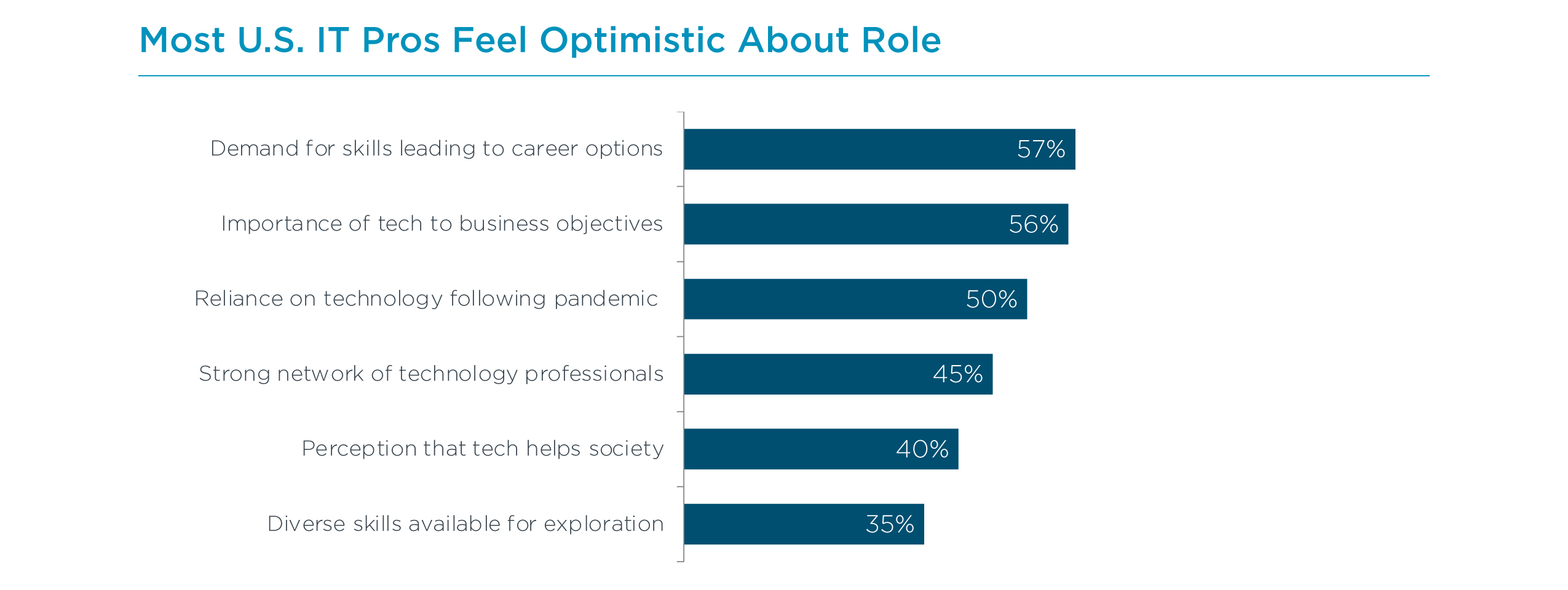
As described in the trends section, technology budgets are flattering middling difficult to specify. Technical training is another exercise of blurred lines: Does that training have to be done within departmental budgets, or are there universal education dollars? The deeper engineering science is embedded within an system, the more difficult it becomes to define the "applied science budget."
With that aforementioned, the regaining to scheme besides seems to be bringing to a greater extent balance to the views around the technology budget. In 2020, only 40% of Information technology pros felt like the technology budget was opportune-sized for the challenges they were facing. This year, that number has climbed to 53%. This sentiment is likely to sweep back and forth based on general economic conditions and personal companion plans, but the increase is a near sign that businesses are soaring out of panic fashion.
Adding to the rosy fiscal picture, a large number of IT pros believe that budgets will live higher next year than they are straightaway. Nearly four proscribed of ten IT pros see budget increases for 2022, compared to only 18% who were predicting increases at this time net year. As always, the terror of the unexpected hangs over these hopes. Although the COVID threat seems to live abating, it remains the greatest unknown of our lifespan. Additionally, geopolitical kinetics have highlighted how fragile the ecosystem can be, especially for provide chains or regulated activities.

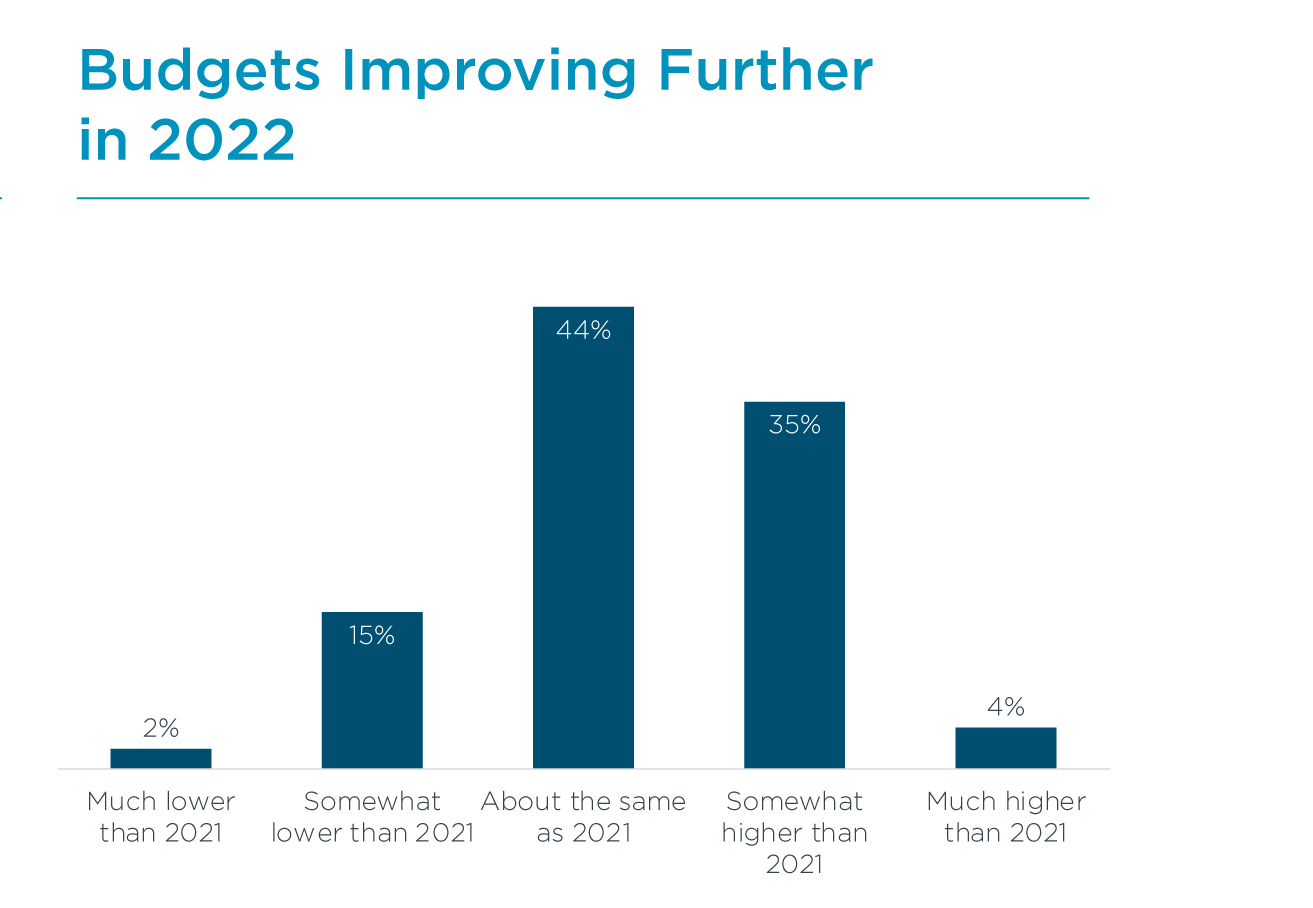
If the budget increases do come to run along, there are cardinal unencumbered areas where IT pros see the pauperism for extra investment. The first point on the like list is innovative, cutting-edge technology. Once once more, this is a sign of a more strategic overture. The subtlety here is that the technology itself is not necessarily the target. After years of nascent tech beingness in the play up, the radiation pattern for adoption has become more clear. Individual technologies such as IoT or AI are not purchased and implemented right away. Instead, these trends factor into broader solutions that benefit a company's operation, such atomic number 3 automation Beaver State ware development.
The second area where IT pros would the like to invest is in collaboration tools. Yet the workplace might embody characterized in the long-lasting term, it will at a minimum include a greater degree of flexibility and virtually credible Be significantly more unfocused. As companies find the properly balance for their fastidious culture and objectives, they will want to be sure that they are maintaining productiveness and enabling innovation. The tools may non be the important hurdle—Soar fatigue is real—but the right tools and infrastructure are shelve stakes for the workforce of the subsequent.
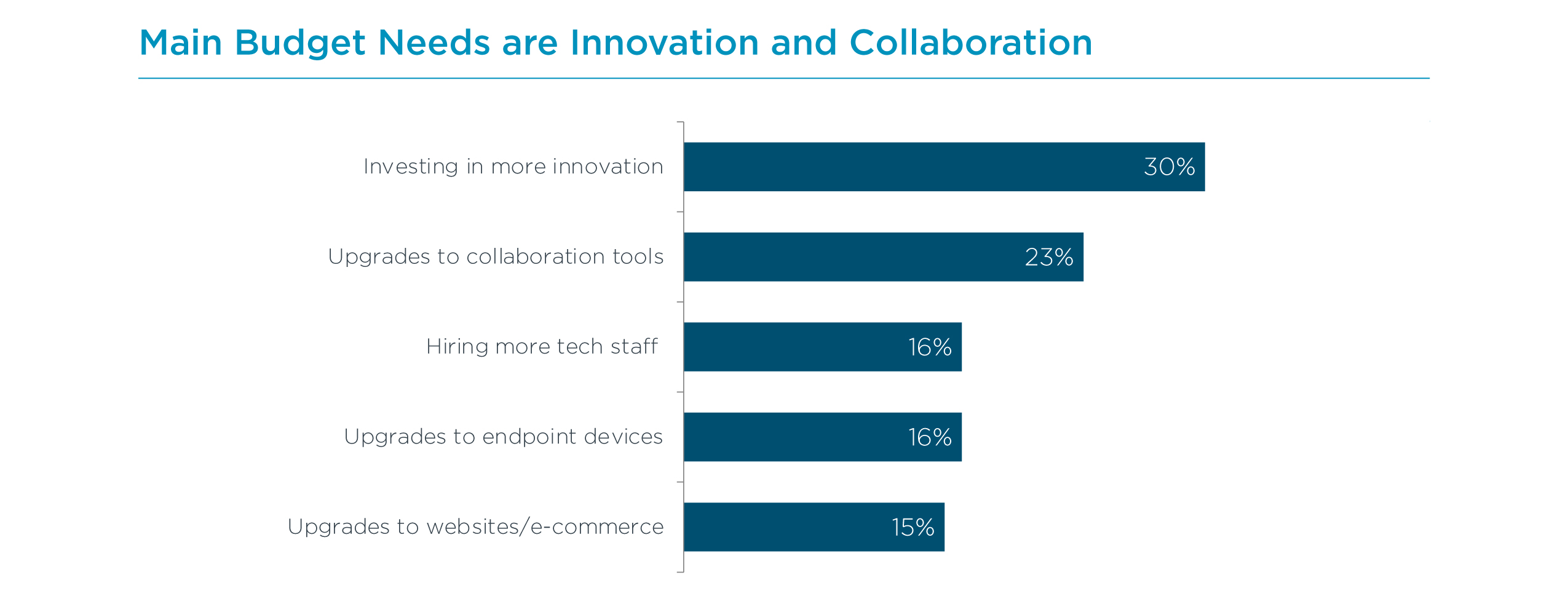
Looking deeper at skills, the IT me keeps evolving from a heavy concentre on infrastructure and generalists into a various world of specialists spread across four fundamental disciplines. CompTIA's IT framework defines base, software development, cybersecurity and data as the pillars supporting IT operations. Looking at each country one by one highlights the layers of complexity that companies are dealing with equally they try to build the best skills within their workforce.
Starting with infrastructure, companies will stay on to prosecute a cloud-first computer architecture. This means considering cloud A the first option for new components and migrating existing systems where the cost/benefit analytic thinking makes sense. As companies set back more than of their IT architecture in the cloud and consider new options for their workforce, networking performance becomes Sir Thomas More critical. Other backend components such as server administration and storage are also function of a broader modernization of the Information technology construction blocks. Nearly uncomparable third of all companies are placing concentrate on first-line support, proving that the helpdesk has quiet not get a commodity in an age of outsourcing and end user tech savvy. The future domain of IoT continues to be a minor focus area, continuing the path of measured adoption that was taking place pre-pandemic.
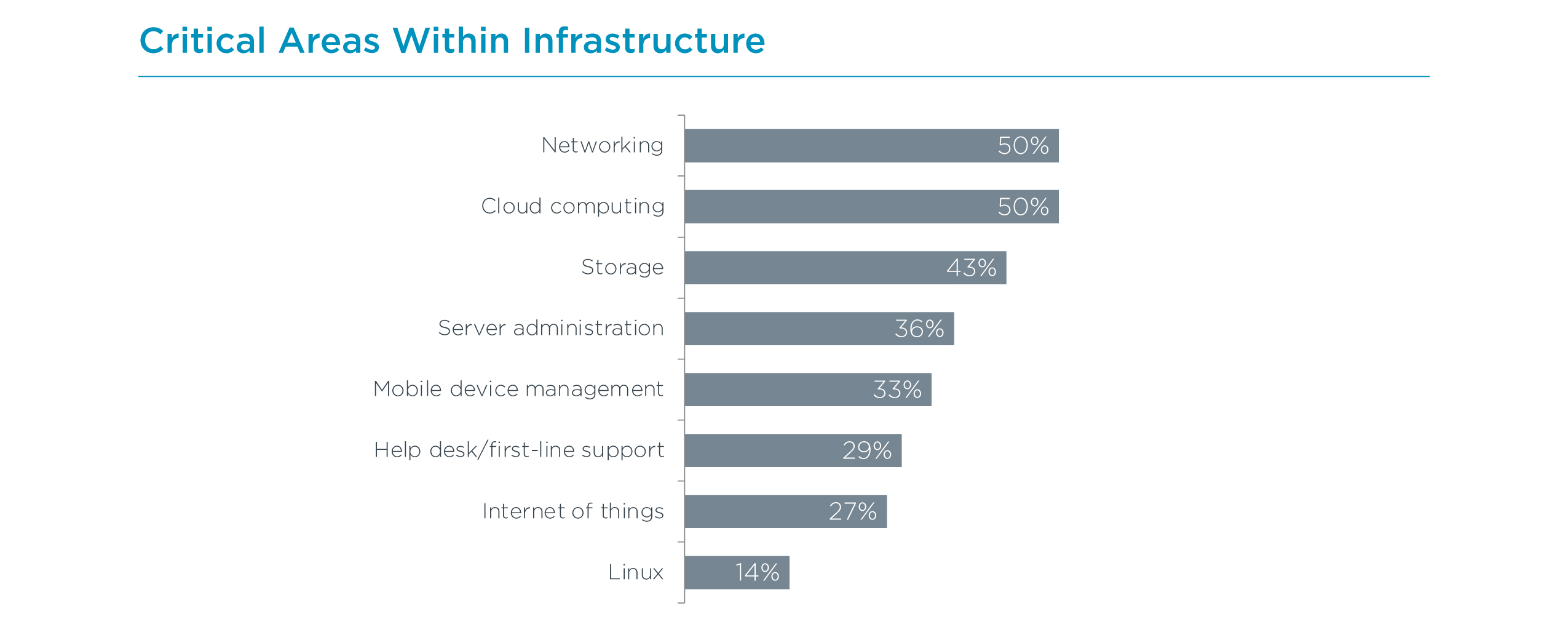
Whether dealing with internal stakeholders operating theater outside customers, companies continue to emphasize user experience in the sphere of software program development. The app approach that became widespread with the plosion of mobile devices redefined expectations round software system usability, and many companies are still climb the erudition curve. The need for quality pledge is trussed to the speeding of development cycles, as organizations are trying to speed their processes without disrupting work flow. Hokey news and political machine learning conduct a step forward this year as companies pitch back to following advantages with intelligent algorithms, and the skills needed are both in development the algorithms and managing the outcomes. As companies build out their software capabilities, they leave drive more fundamental interaction between software development and infrastructure trading operations, leading to more demand for DevOps.
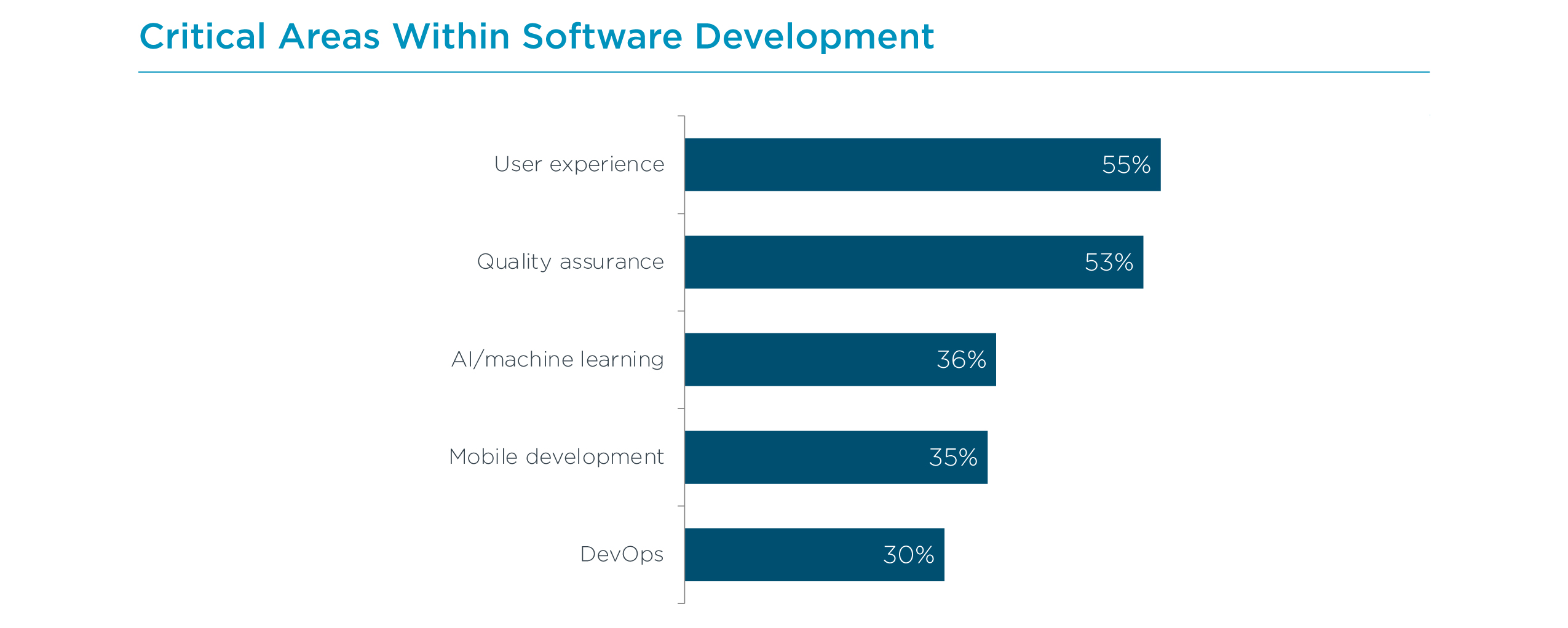
Cybersecurity is possibly the most complex of the four pillars, masking expanded defenses that companies must build, groundbreaking approaches to proactively tryout those defenses, and internal processes that create secure trading operations. Privacy is top of creative thinker atomic number 3 the uses of information in a appendage economy continue to be scrutinized. Risk analysis, cybersecurity analytics and penetration testing are all areas that need improvement Eastern Samoa companies adopt a zero intrust mindset. Cybersecurity metrics are starting to get more focus on as a way of bridging the gap between cybersecurity best practices and business health. Workforce teaching is possibly underrated as a priority. New concerns that stem from a remote workforce have been a primary trigger for both security system awareness education and security investments.

Finally, the field of data is non mark up to be a consecrated function as oftentimes as cybersecurity, just it is still a domain where businesses are difficult to establish comprehensive examination policies and management. Database administration is still the acme focus area heading into 2022, as many companies continue to locomote away from spreadsheets and other simplistic forms of data management. The emphasis on data direction and policies shows that businesses are beginning to use up a more than large feeler to their data, which successively will drive Thomas More specialization. Spell data visualization and predictive analytics have relatively strong demand, those areas are still tricky to tackle without a holistic data management strategy. As far as cutting-margin technologies, straggly ledgers such as blockchain sustain tremendous potential, but there are stock-still hurdle race in implementation and the technology will most probably persist a degree separated from near end users.
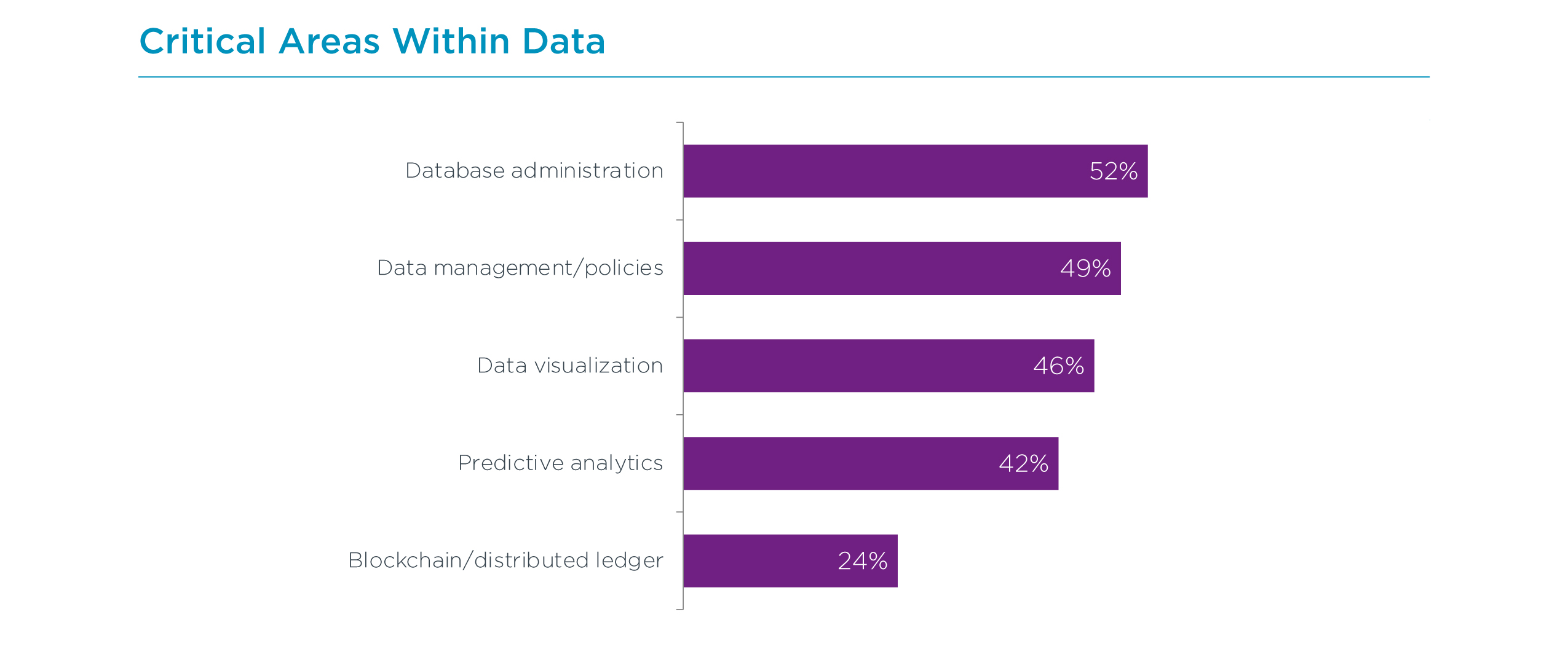
Adding to the challenge of filling a broad scope of skills, companies are generally looking candidates with deeper expertness. Crosswise all four IT pillars, hiring companies are primarily targeting either early career (3-5 age of experience) or mid-steady (6-10 years of experience). In fact, the focusing on this level of expertise is slimly greater than information technology was heading into 2021. Targeting a higher level of experience Crataegus laevigata make sense in the areas of base and software development, where businesses have built a hierarchy of skills ended time. For cybersecurity and information, the situation is more complicated. These areas, which induce traditionally been subsets of infrastructure and development, have relied happening those foundational pillars to ply the entry level skills. Now that they are distinct functions, there are difficulties in creating the pipeline for more advanced talent. Over time, unveiling-level positions will likely egress, but in the meantime, companies will have to explore varied avenues for filling their skill gaps.
In that location is greater interestingness in parvenue hiring for 2022 compared to 2021, merely the favored method acting of closing skill gaps is still training the existing hands. Solitary 47% of companies expect to bring on new headcount in 2022, compared to 71% that plan on pursuing training options. In addition, 46% of companies be after on certifying their workforce, which validates strong skills around the latest technology. When IT comes to career growth, there are three distinct areas IT pros expect to develop. Best is technical skill within their existing specialization. With so many different topics within each pillar, there is plenty of room for growth. Second is teamwork and communicating. Arsenic technology regains a more strategical flavor, in that respect is a greater need to explain technical hurdles and collaborate connected unique solutions. The ultimate direction for career growth is technical skill in a new area. The four pillars interact in unique shipway, and these overlaps define how business solutions are built and maintained.

There are two other topics for 2022 that impact the IT pro outlook to varying degrees. The first is the placement of the work force. Expectations for 2022 are clearly still different than pre-pandemic levels, but there is certainly some movement back toward workers being located in offices compared to 2021 expectations. Much has been written about employees rejecting this system. While CompTIA's sampling is a single data point, information technology provides a counterargument. Of the IT pros who consider that their company wish plan for nearly or all employees to be based in corporate offices, only 10% say they are definitely looking for a Job with more location flexibility because of their company's conclusion.
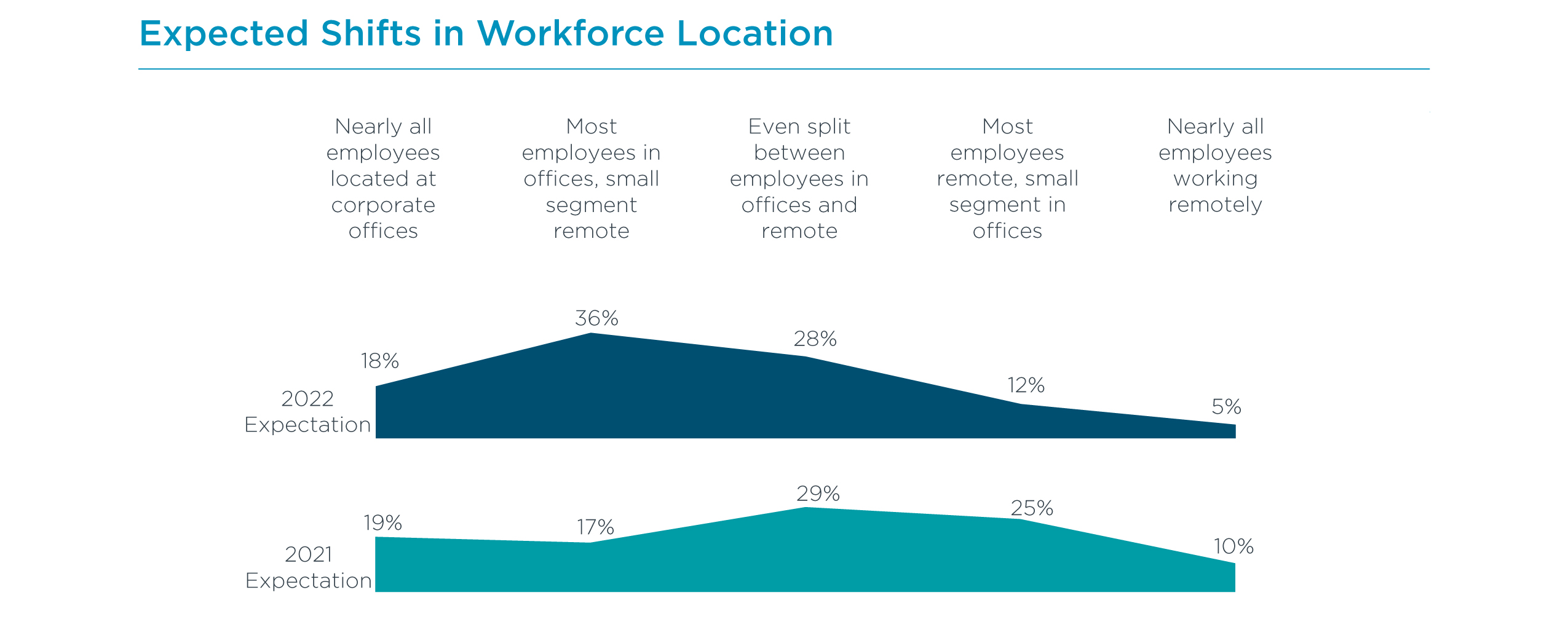
The willingness to remain in an office-based business may be related to the nature of IT influence. Over 70% of IT pros say that they plan to be at an office full-time OR the majority of the clip, which is clearly more than the percentage of companies mandating a return. There are certainly a phone number of challenges involved with doing engineering science work remotely, including difficulty collaborating with technology colleagues (cited by 40%), difficulty centerin on difficult problems (cited by 39%), and a preference by employees for personal discussions (cited away 35%). As organizations are discovering how to rebuild the workplace, IT pros will also be discovering how to adapt to the billet.
The other topic looming in 2022 is not exactly a new issue. Diversity has not been solved, especially non in the field of technology. IT pros are aware of the problem—53% think that there is more diversity in the broader organization than within the IT department, and merely 7% consider the IT section A more diversity—but they may not cognize what to do about it. Although mandatory trainings have become a cliché, there are solemn issues around creating inclusive spaces, and all employee should study themselves part of the solution.
The past year has shown that progress is ne'er a guarantee. There are still questions about the future, but the candescent at the end of the tunnel is growing brighter. Even with some tarriance doubts, companies are reversive to the engineering mindset that had been developing throughout the past decade. The critical nature of Information technology, both for maintaining operations and for pursuing new growth, creates hopeful prospects for IT pros as they build their careers.
THE BUSINESS OF TECHNOLOGY PREPS FOR BETTER FORTUNES, NEW INITIATIVES
Much like IT professionals, companies in the business organisatio of technology (aka the channel) are opening to think big again, rekindling whatsoever of the strategic initiatives and aspirations that whitethorn have been put on the back burner during the extended pandemic. Even among those firms that have struggled during COVID, there is a sense of revived still dilatory determination entering 2022. Whether it's building back a solid foundation that had cracked a bit these past couple geezerhood surgery forging ahead with ambitious business decisions aimed forthright at the subsequent, the transfer seems ready to accelerate.
Consider this glass-uncomplete-full judgment: Nearly eight in x channel companies in this year's study aforesaid they are positive about their solid's prospects for 2022, including 37% that are feeling "very good" and 40% feeling "pretty proficient." That's a nice kick downstairs up from the 63% that felt similarly about their ain company a year ago. Among the glass-uncomplete-empty contingent? Just 5% this yr said they feel uneasy or very uneasy about their business prospects As we routine the calendar page to 2022.
There is no doubt that applied science and the business of selling IT continues to make up ever more full of life to everyday life. The industry itself is more building complex and changing rapidly at both the technology and business enterprise levels. From the communication channel's viewpoint, what was once a stable set of infrastructure products in a reseller's portfolio has, in the cloud long time, morphed into a cornucopia of software-as-a-service applications, data and cybersecurity tools, and a stack up of emerging technologies to contend with. At a business model level, consulting and influencing have established themselves American Samoa legitimate—often lucrative—paths to prosecute. Finally, 1 of the most consequential developments touching the line today is the rise of online marketplaces, which upends the entire buying process and impacts actions that follow.
Looking in the lead to 2022, firms that bring off to thrive will be hiring once more, fashioning investments in skills training, expanding their grocery store reach to new customers and verticals, partnering with competitors and embracing emerging tech. For many, that means getting out of their comfort zone. And more are ready to answer sol. After nearly two geezerhood of stasis and economic uncertainty, signs immediately point to investment and the pursuit of technical and stage business innovation that pairs well with the counseling the industry is heading.
Consider the factors channel firms say testament be key to achieving positive growth in 2022 and how they've repositioned from the previous year. In 2021, respondents said growth was predicated on picking aweigh business from existing clients, which made sense in the pandemic-drenched economic mood that ready-made finding inexperient customers challenging and budgets tight. But looking ahead to next year, respondents now say arrival new clients is the No. 1 factor to drive away growth. Nobelium one's forgetting their circulating customers, naturally, simply the hunt is on for recent ones to fill the pipeline.
Also indicative of a many hopeful stance to the unused year, one third of respondents pointed to the ability to sell new occupation lines and/or products and services as distinguish to growth. This could awful expansion into some of the emerging engineering science disciplines, specializing in a brand-new vertical operating theatre doubling down along a services-supported business heavy on consulting, to name just a few directions channel firms power venture to spur growth.

Firms are also counting on a riposte to typical commerce patterns. One third of respondents say this is necessary, and they are most likely referring to the delivery and forecasting bottlenecks that have resulted from the last two eld of pandemic-direct supply chain disruptions. Carry firms have sex that landing place new customers is great, but a ephemeral win if you end up disappointing them on delivery timing and logistics. Poor customer experience just throws cool weewe connected the entire relationship. And today, more than ever, providing A+ customer experience ranks high in the return to strategy.
Other areas respondents are looking for as outgrowth drivers: more business from existing customers; higher COVID vaccination rates, presumptively among staff, customers and suppliers; and improvements to sales and merchandising acumen/efforts.
What could derail 2022? A year ago, it was the continued effects of COVID-19 and whether that would resultant in sluggish client demand and postponed purchasing. This year is no different: Respondents still worry about COVID's long tail and vaccinum reluctance, as well as customers pumping the brakes on purchasing. In keeping with this theme, they also are concerned that some other unexpected macroeconomic shock to the thriftiness—so much as a brave-corresponding cataclysm or financial crash—could derail growth plans.

The burden COVID has had on businesses in the channelize is undeniable, with one third of companies coverage much downside impact in the past twelvemonth. And in time, that's advance; in 2020, incomplete of respondents said COVID affected them negatively. For those companies that reported more or less Gram-positive impact of COVID, there was also an increase year over twelvemonth. In 2020, 25% of TV channel firms aforementioned their clientele benefitted in some way during the epidemic; that percentage bumped equal to 31% in 2021. Some of this upside came from the continued opportunity to assist customers with the mass move to and management of inaccessible work on, which enclosed a wide variety of activities from twist gross sales and implementation to cybersecurity consulting and oversight. Additionally, a segment of customers accelerated their digital shift efforts during the pandemic, using outside firms from the channel to wait on them in the journey.
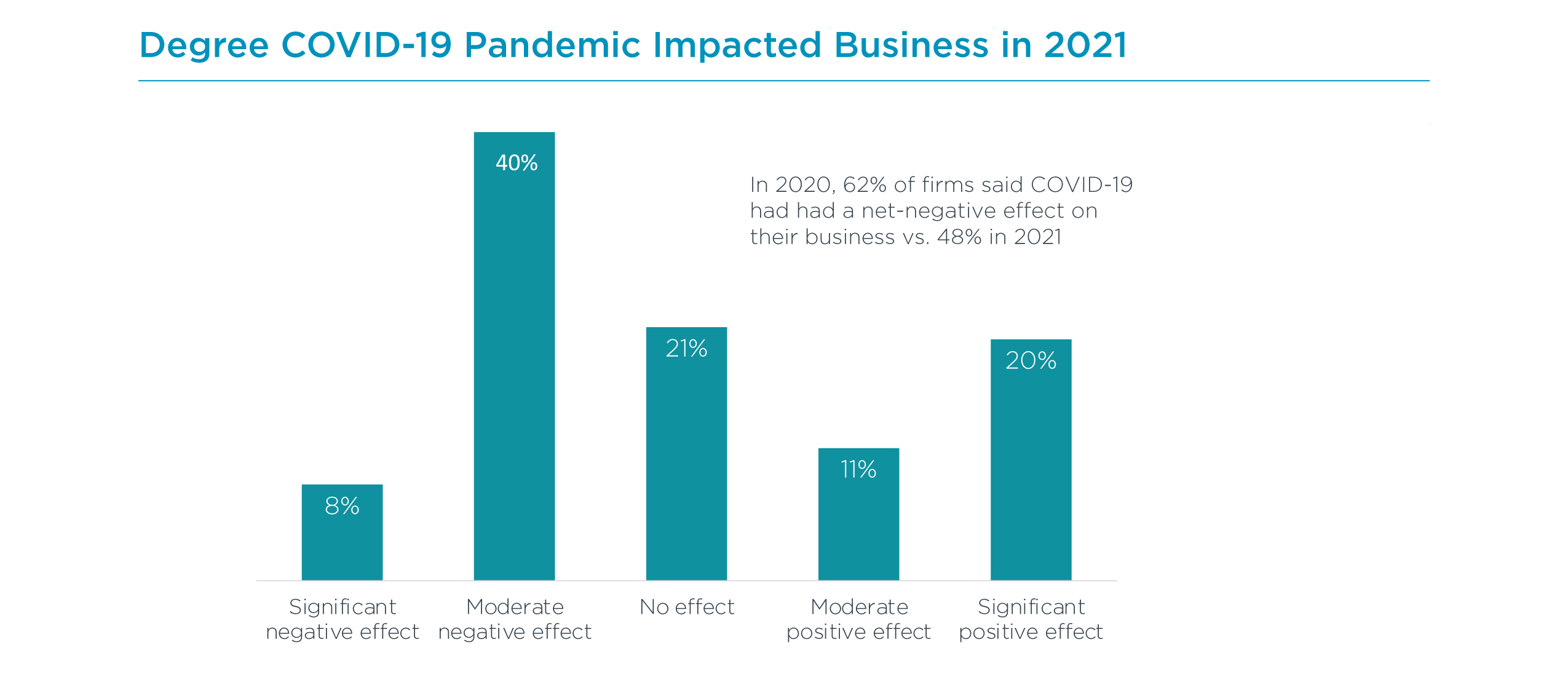
Looking for ahead to 2022, uncomparable third of companies are expecting a cyberspace-constructive effect of the tarriance pandemic, while 27% are still with kid gloves concerned or so a net-unsupportive shock. Other 31% are putt the general in the rearview windowpane businesswise, predicting no touch on up or down in the coming year. It's clear that as customers commenc to recover from the epidemic's torrent, they will be building back technology budgets, reigniting projects that had been stalled, and looking for shipway to advisable prepare for any future crises of the same typewrite. Easily-positioned channel firms should seek to be involved in many of these turnaround time activities.
From a taxation perspective, things are looking solid. The optimistic absolute majority (58%) expect that they bequeath either grow tax income in 2022 in redundant of both 2021 and 2020 results OR will recoup any losses from 2020 and 2021 to return to 2019 revenue levels or beyond. Other 36% expect to remain stable with 2021, though that could be a revenue level that was little than 2019 for those firms. When we sing about a return to strategy, revenue development expectations are a major indicator of a companion's power to execute. For 2022, execution substance pivoting to a services-based business sector, getting serious about emerging tech opportunities, and double shoot down in a more sophisticated way with cybersecurity efforts and offerings.

Of all the indicators of a return to strategy away channel firms, budget forecasts for 2022 are the most demonstrable—especially when compared with projections made a twelvemonth past. Looking ahead to next year, a majority (53%) of channel companies ask to have higher tech budgets, while lonesome 28% did so in the same timeframe last year. Even the number of companies that expect the same budget allocation in 2022 as 2021 declined importantly from 41% to 26%.
More than money in the coffers typically means more spending. This positive growing most apt signals a deliver to initiatives such as entering new markets, branching into new services and skills, hiring and recruiting, and investing more in sales and marketing.
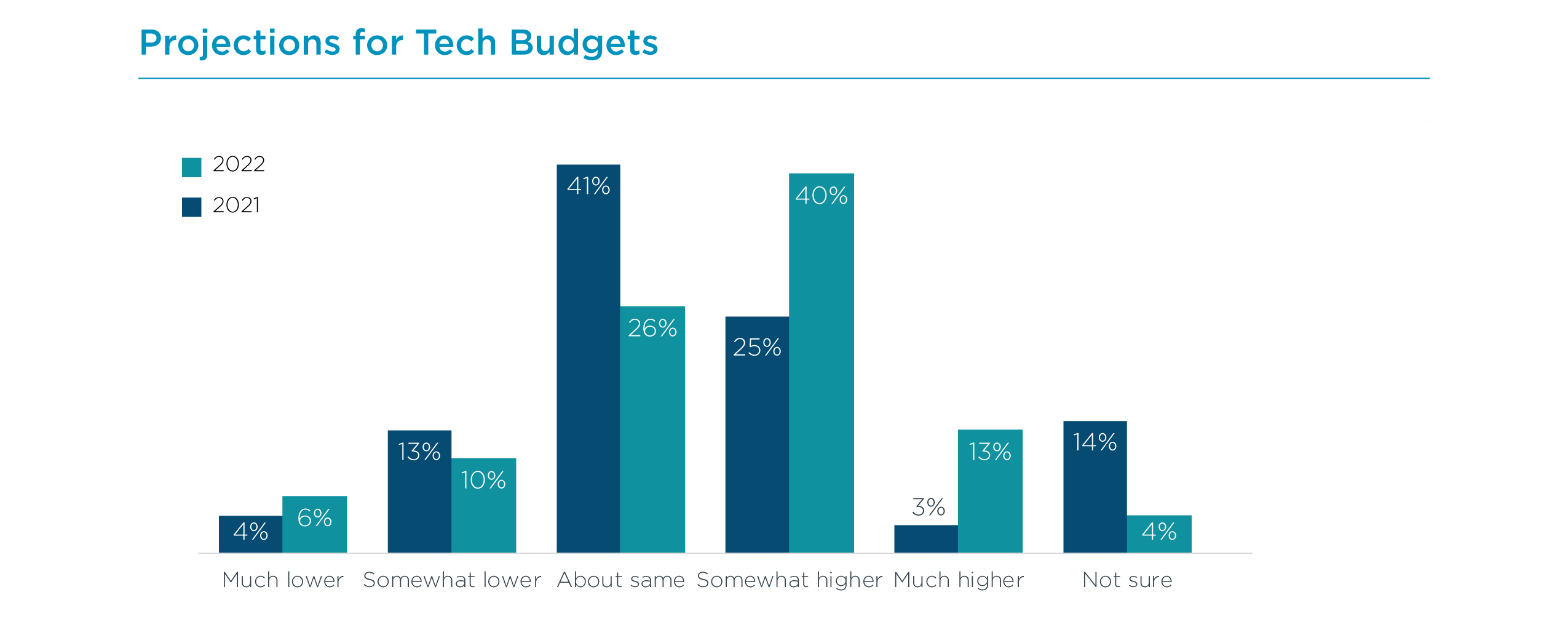
In addition to new areas of pore, transfer firms in 2022 are committing to extending and growing their existing portfolios. Nearly quatern in decade are pushing ahead with their current offerings. It's likely they've held hindermost during the last year or cardinal in growing those business lines or introducing them to new audiences. With more budget at their disposal and greater optimism in general, companies are now freer to brush up their core business for the future. New services and solutions factor in besides, notwithstandin. Nearly half (49%) of respondents said they are either mostly focusing connected brand-new areas so much as emergent technologies operating theatre paying equal attention to some inexperient and existing lines of business. This reflects a smart balance, especially in a time of continued doubtfulness, even if it's tinged with to a greater extent hopefulness than a year past.
That said, companies are quite bullish along their expectations for revenue growth over the next two years for their existing products and services offerings (Figure Vermiform appendix). Three quarters of respondents betoken moderate to meaningful development in these areas, while just 7% forecast a downslope in gross revenue. Among the largest conduct firms (100+ employees), a full tierce expect significant growing from their solutions and services sales in the coming two years. Many of these firms have felt a pinch because of supply chain issues during the pandemic and reticent customers disbursal. As those negatives set out to wane, business activity should accelerate.
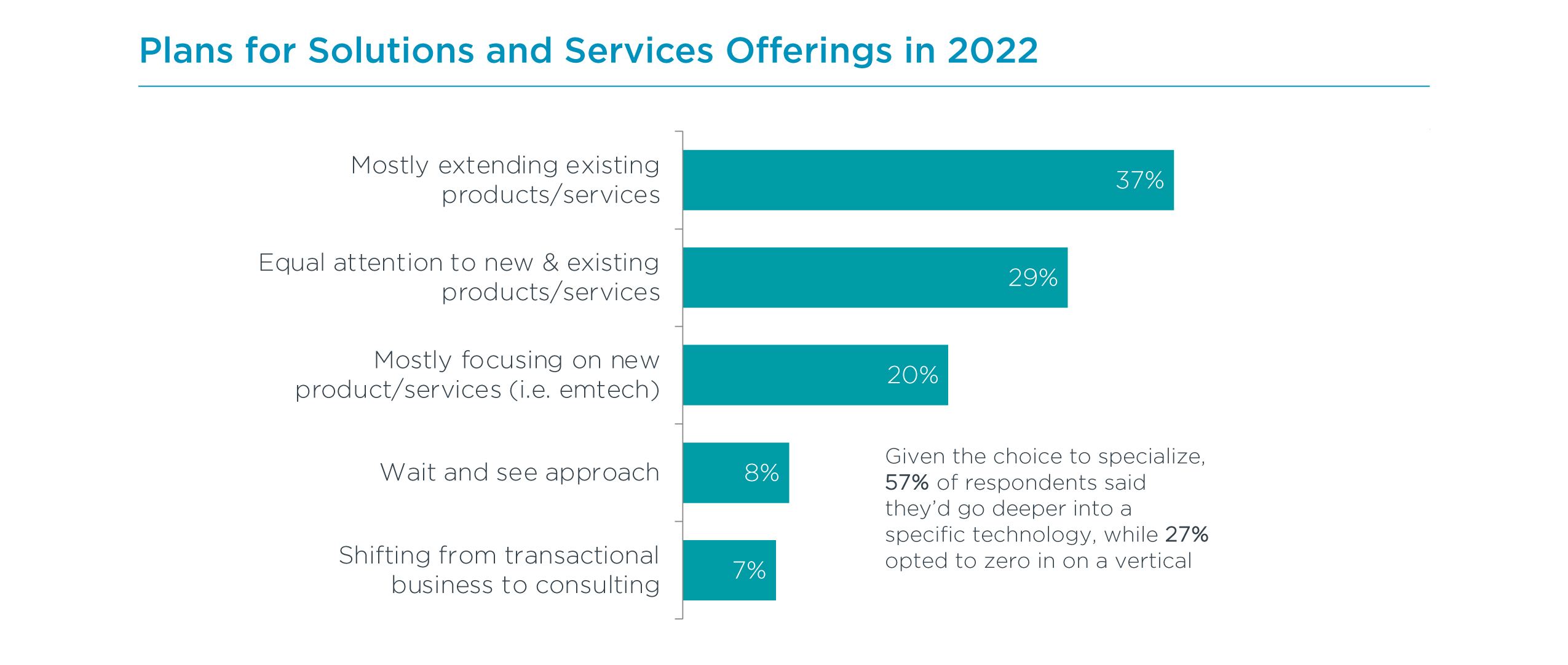
Respondents have some clear opinions on what department areas are getting sufficient allocation in their overall budget versus those areas that could manipulation either more Oregon less in 2022. While roughly incomplete of respondents conceive financial backin is where it should be crosswise all five functional areas surveyed (sales, merchandising, operations, finance, technical school keep going), sales and marketing rate highest as areas being slightly shortchanged. Merchandising is an obvious one for this distinction. For many channel firms, this activity has always lagged in both imagination allocations and general attention. Few channel firms employ a regular marketing staffer and the discipline itself has often been unnoted, but on the bright side, data of the last single long time shows a more concerted effort close to marketing, messaging and stigmatisation. Baby stairs.
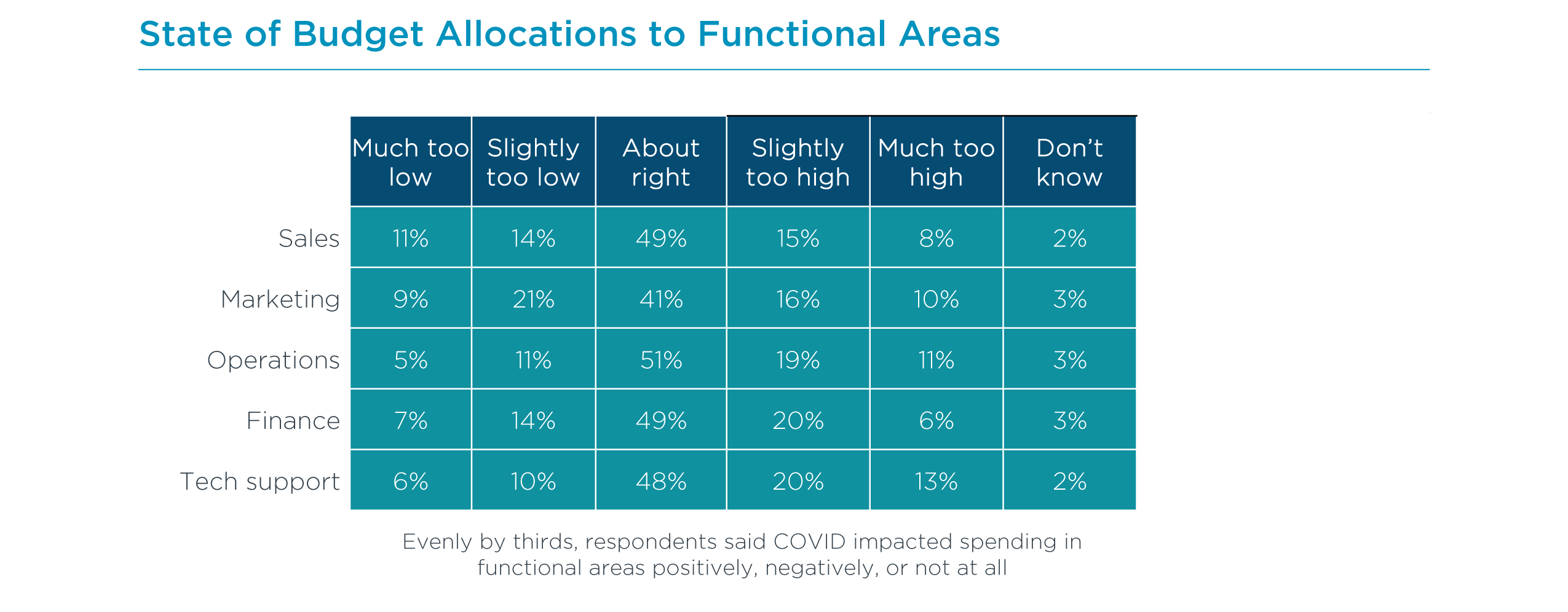
Last year, a walloping 31% of channel firms feel that the budget for technical school support inside their organization was to a fault low—ironic seeing Eastern Samoa tech support is a core mission for nearly channel firms. This could throw been due to the unforeseen deluge of tech endorse calls from customers whose workforces went far overnight. This year, respondents are looking much happier with what their firms are allocating for tech suffer, with just 16% now saying it's too low. Channel firms may have gotten the message that remote work is here to stay and consequently spent to gain capacity to run into need.
Understanding the customer—who they are, what they prefer/need, how they buy—is a crucial ingredient for communication channel achiever in the new yr. For years now, the industry has seen a slow but stabilise shift in who holds the purse strings when it comes to technology deciding and procurement. To a greater extent and more line of business executives today possess tech budget and routinely make critical purchasing decisions for their departments and stave—some with and without the involvement of an internal IT section. This has necessitated change within channel firms quest to work with these customers, especially with respect to sales techniques and activities, also arsenic marketing messaging and the choice of conduits for communication.
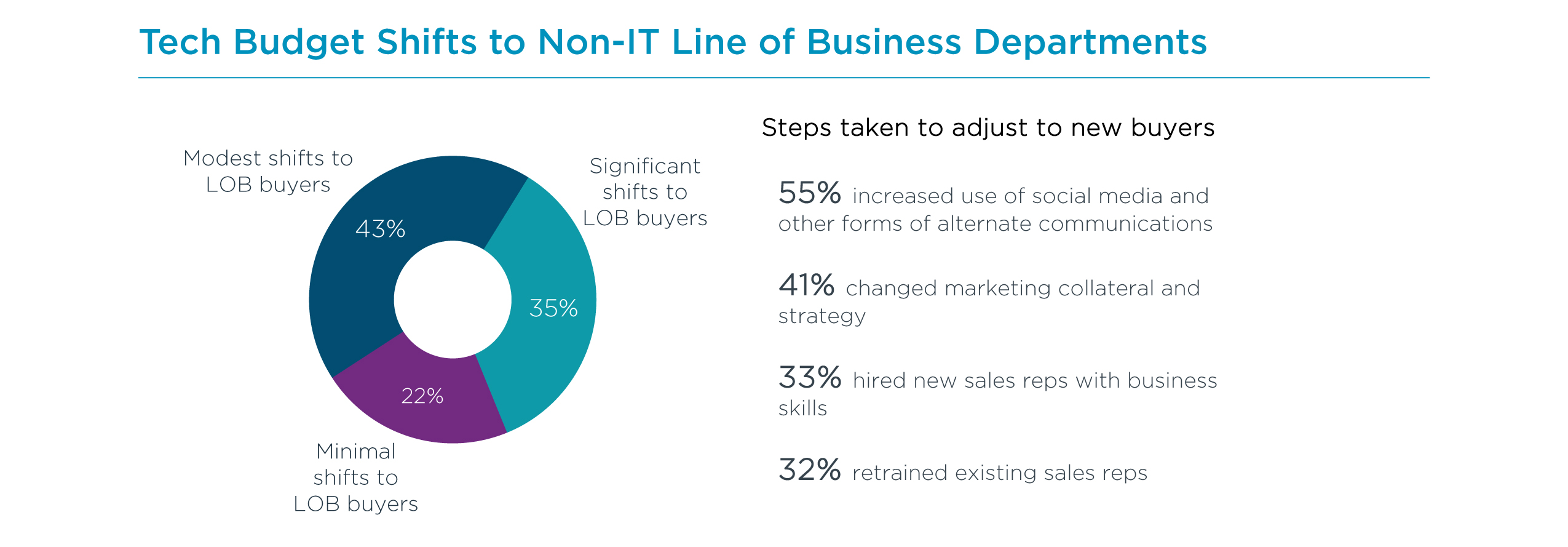
More than uncomparable third of respondents report world-shaking shifts to LOB buyers in their customer traffic, with other 43% experiencing a minor shift. That's non anything to brush off. These are buyers who will expect a business conversation from their sales reps. They want a channel provider that has unique knowledge of their business's primary mission, operational idiosyncrasies and ultimate goals. And then they expect their partner to have intercourse how to apply the right technology, demonstrate consulting acumen, or provide on-going services ferment to account for each of those objectives. The shift in conversation can be daunting for some used to selling speeds and feeds to a technical school vocation, but the skill will be essential moving low as take off of overall improvements to customer experience.
Consider the following from CompTIA's research study, Customer Feel Trends in the Channel. The top three items cited as critical to the future health of the channel were:
- Providing a desirable customer experience as a competitive differentiator
- Recognizing shifting customer dynamics and selling consultatively
- Increasing investments in selling
It seems many in the channel are taking listen of that advice. More than half (55%) are appealing to spick-and-span types of buyers away magnified consumption of social media for marketing, sales and communications; 41% have changed their alive marketing corroborative and whole strategy; and incomparable ordinal receive chartered new sales reps that crackleware with business skills and the vernacular to appeal to LOB executives.
It's wise that channel firms are occupancy this steering, in part because in that location is an elephant in the room they must acknowledge: online marketplaces. Today, online marketplaces, much as those from Amazon and Google to Microsoft and Salesforce, have become the direct, rifle-to option for many technical school purchases in today's cloud up earned run average. Everything from hardware devices to SaaS applications and beyond is available at the click of release for customers today. This could puncture duct firms that now feel displaced from the cut-rate sale, but marketplaces don't necessarily have to do so. A synergy exists for those channel firms that adjust in their business model to follow more informative and specialized, while emphasizing the after-market services that customers will very much need after first tech buy.
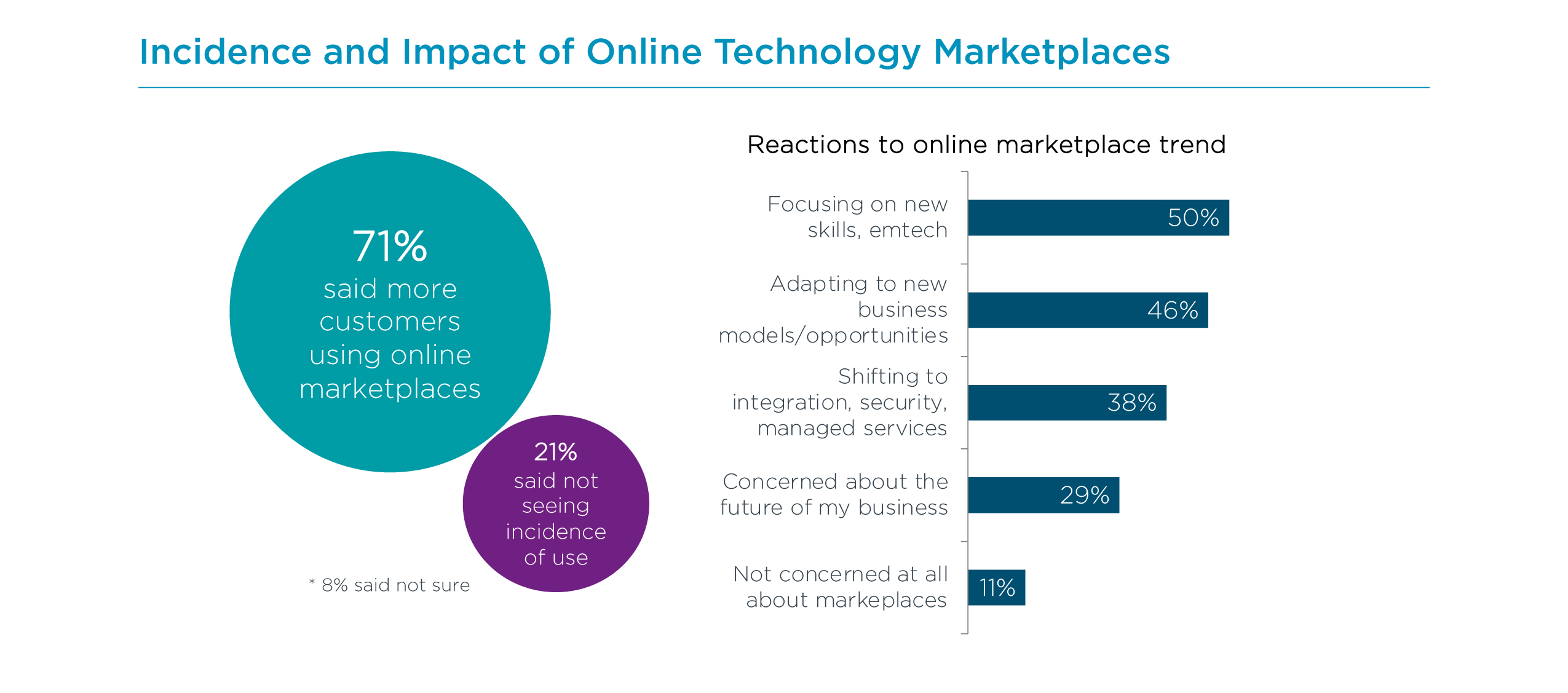
Strategic adjustment is key because marketplaces are a trend that's not leaving. Nearly three living quarters (71%) of channel firms acknowledged that more customers now are using marketplaces for their initial purchases. To deny the impact of marketplaces would be folly. Compass channel firms instead are brush up connected new skills, especially in the emerging tech areas, so they can be a go-to advisor to customers as they dip their toes in this unfamiliar with territory. Strange moves include being more flexible to new opportunities and clientele models. A transactional simulation today mightiness no more be tenable and meliorate replaced by a managed services type business approach, for example.
It should also be noted that customers aren't the only group that give the sack avail itself of the easy-to-buy environment of an online mart; channel firms can as cured. Whether procuring products and applications from the marketplaces to then sell to customers or directive clients to the rightish particular sold on Amazon to fit their necessarily, there is opportunity for a relationship to exist between the two entities.
Along with considerations around gross, budgeting and client dynamics, the hominid resources factor all TV channel companionship faces can't be unnoticed. Staffing, open positions, skills gaps, retention, diverseness—each area presents a ambitious here and now for employers. Despite current pandemic conditions, many channel firms are nonetheless along the hunt for novel employees, particularly those with skills in certain areas such as emerging technical school (IoT, AI, etc.), as fountainhead atomic number 3 clientele acumen for sales and merchandising positions. More than a third (35%) of firms report having stream openings they are actively looking to fill in technology roles. Another 24% are angling to shore up their business-incidental to employee base, an increase from 15% last yr. Xxxii pct are in full staffed now, while 7% aforesaid they remain in a hiring freeze directly related to COVID-19's impact. In 2021, 13% were in a hiring freeze due to COVID.
The business simulation, technology focus and type of customers served testament greatly influence the staffing needs of the typical channel firm. For exemplar, a managed services supplier may asymptomatic need to a greater extent tech staffing now that a majority of its customers are working from home instead of a cardinal office location. Other companies are rassling to fill staffing holes because some of their employees needed to leave the workforce to tend to school-age children at home during the pandemic. Other television channel firms are victimisation their substantial financial counterfeit and positive cash flow to dive into parvenu markets and grow during this hesitant time. For other firms, it's about strategic thought process and finding people with skills to tackle the nuances of the emerging tech landscape.
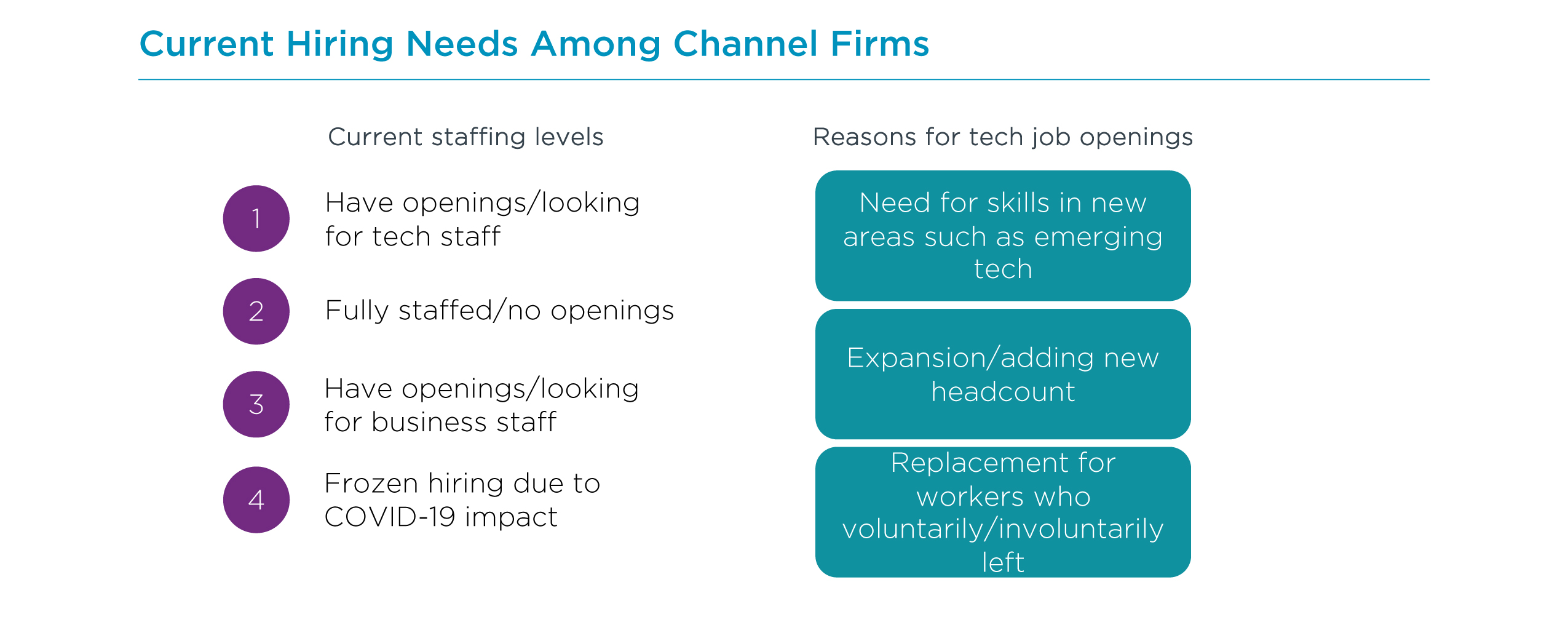
Emerging tech skills are in high demand among channel firms, and often hard to find. Simply different obstacles have complicated hiring as well, including rebellion salary expectations and competition for talent from other tech providers. Increasingly, another industries outside of tech are in the mix for potential subcontract candidates. And while last class's approach to hiring issues was first of all to retrain existent staff for open positions or to accost early areas of focus, this year duct firms revolved to narrow down (1099) workers to sate open positions. This might reflect a reality of COVID-ERA utilisation shifts and the gig economy generally, surgery contract hiring could be seen Eastern Samoa a way to combat salary demands of regular hires. For those hiring externally, recruitment efforts that assay out more diverse applicants is underway. Others give eliminated the Little Jo-year college degree requirement altogether.

Appendix
Active CompTIA
The Computer science Technology Industry Tie (CompTIA) is a leading voice and preach for the $5.3 jillio global information technology ecosystem and more than 50 million industry and tech professionals who designing, implement, manage and safeguard the technology that powers the world's economy. Through and through education, training, certifications, philanthropic gift, and market explore, CompTIA is the hub for advancing the technical school industry and its workforce.
Just about this Report
CompTIA's IT Industry Outlook 2022 provides insight into the trends shaping the industry, its workforce and its business models. Because trends do non occur in a vacuum, the story provides context through commercialize sizing, workforce dynamics, and other references to supporting data. The interrelated nature of technology—where elements of infrastructure, software system, data and services arrive together—agency trends be given to unfold in a measure-like personal manner. A breakthrough may lead to a notability advance, which may then be followed by what could be perceived As lateral movement as the else inputs catch-up. Some of the trends highlighted in this news report center on an early-stage facet of a trend, while others make out a style moving beyond buzzword to reach a predictable stage of market-ready maturity. As such, the timing of trend impact may motley from reader to reader depending on company type, lin function or country. Lastly, this report is not meant to cover every trend in the industry. Opposite trends are covered in additional CompTIA inquiry. Visit www.CompTIA.org for last versions of the Information technology Industry Outlook and an extensive subroutine library of research and educational substance.
Read more about IT Workforce.
Internal Revenue Service Center for the Area Where You Live
Source: https://www.comptia.org/content/research/it-industry-trends-analysis
Belum ada Komentar untuk "Internal Revenue Service Center for the Area Where You Live"
Posting Komentar